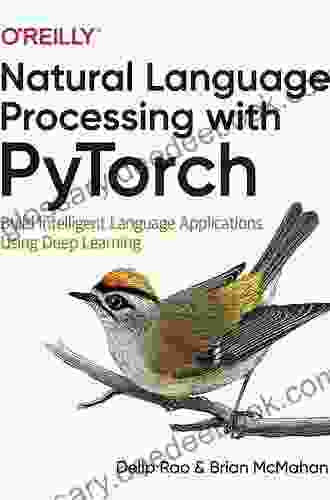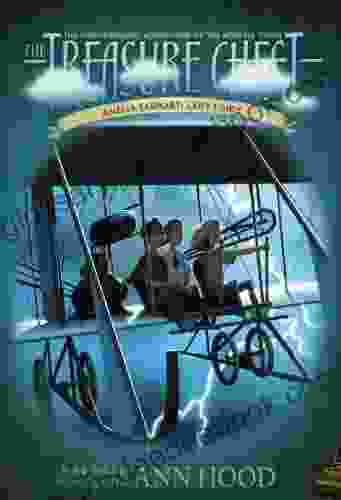Natural Language Processing With PyTorch: Build Intelligent Language Applications Using Deep Learning

In today's technologically driven world, language plays a crucial role in seamlessly connecting humans and machines. The advent of deep learning has revolutionized the field of natural language processing (NLP),empowering us to build intelligent language applications that can read, understand, generate, and translate text with remarkable accuracy. This article delves into the intricacies of deep learning for NLP, providing a comprehensive guide to harnessing this powerful technology to create innovative language-based solutions.
Understanding Deep Learning
Deep learning is a subset of machine learning that employs artificial neural networks (ANNs) with multiple hidden layers to learn complex patterns and relationships in data. These ANNs are inspired by the structure and function of the human brain, allowing them to process information in a hierarchical manner. In NLP, deep learning models excel at tasks such as:
4.1 out of 5
| Language | : | English |
| File size | : | 10590 KB |
| Text-to-Speech | : | Enabled |
| Screen Reader | : | Supported |
| Enhanced typesetting | : | Enabled |
| Print length | : | 373 pages |
- Sentiment Analysis: Determining the emotional tone or sentiment expressed in text.
- Natural Language Understanding (NLU): Extracting and interpreting the meaning of text.
- Machine Translation: Translating text from one language to another.
- Text Summarization: Condensing large amounts of text into a concise summary.
- Text Classification: Classifying text into predetermined categories (e.g., topic, genre).
Popular Deep Learning Models for NLP
The choice of deep learning model for an NLP task depends on the specific requirements and complexity of the task. Some popular models include:
- Convolutional Neural Networks (CNNs): Effective for tasks involving structured text data, such as sentence classification and question answering.
- Recurrent Neural Networks (RNNs): Handle sequential data well, making them suitable for sentiment analysis and text generation.
- Transformer: A recent architecture that has achieved state-of-the-art results in various NLP tasks, including machine translation and summarization.
Building NLP Applications with Deep Learning
Constructing NLP applications using deep learning typically involves the following steps:
- Data Collection and Preprocessing: Gather and clean relevant text data to train the deep learning model.
- Feature Engineering: Extract meaningful features from the text data to enhance model performance.
- Model Selection and Training: Choose an appropriate deep learning model and train it on the preprocessed data.
- Model Evaluation: Measure the performance of the trained model using relevant metrics and make necessary adjustments.
- Integration and Deployment: Integrate the trained model into the target application and deploy it for real-world use.
Benefits of Deep Learning for NLP
Leveraging deep learning for NLP offers several significant advantages:
- Accuracy and Robustness: Deep learning models can achieve impressive accuracy and robustness in handling various NLP tasks.
- Self-Learning: These models learn from data without the need for explicit programming, making them adaptable to new domains and tasks.
- Generalizability: Deep learning models trained on large datasets can generalize well to unseen data.
- Automated Feature Engineering: Deep learning algorithms can automatically extract relevant features from text data, reducing manual effort.
Case Studies of Deep Learning in NLP Applications
- Chatbots: Deep learning-powered chatbots provide human-like conversation with enhanced understanding and response generation capabilities.
- Text Summarization Tools: Deep learning models revolutionized text summarization, allowing for the automatic generation of concise and coherent summaries.
- Machine Translation Systems: Deep learning-based machine translation systems have achieved near-human-level performance in translating text across different languages.
- Fraud Detection Systems: Deep learning models are used to identify fraudulent text in various domains, including financial transactions and customer reviews.
Challenges and Future Directions
While deep learning for NLP has achieved significant success, several challenges remain:
- Data Quality and Size: Deep learning models require large amounts of high-quality data for training.
- Interpretability: Understanding and explaining the reasoning behind deep learning model predictions can be difficult.
- Bias and Fairness: Deep learning models can inherit biases from the training data, leading to unfair or inaccurate outcomes.
Future research directions in deep learning for NLP include:
- Few-Shot Learning: Developing models that can learn from limited data.
- Transfer Learning: Transferring pre-trained models to new tasks to improve efficiency and performance.
- Multimodal Learning: Integrating text data with other modalities (e.g., images, audio) for richer understanding.
Deep learning has transformed the landscape of NLP, enabling the creation of intelligent language applications with unprecedented capabilities. By harnessing the power of deep learning, developers can unlock the full potential of text data, empowering machines to understand, generate, and translate human language with remarkable accuracy. As research continues to address the challenges and explore new directions, deep learning for NLP is poised to drive even more transformative innovations in the years to come.
4.1 out of 5
| Language | : | English |
| File size | : | 10590 KB |
| Text-to-Speech | : | Enabled |
| Screen Reader | : | Supported |
| Enhanced typesetting | : | Enabled |
| Print length | : | 373 pages |
Do you want to contribute by writing guest posts on this blog?
Please contact us and send us a resume of previous articles that you have written.
 Novel
Novel Page
Page Chapter
Chapter Story
Story Reader
Reader Paperback
Paperback Magazine
Magazine Newspaper
Newspaper Sentence
Sentence Bookmark
Bookmark Bibliography
Bibliography Foreword
Foreword Annotation
Annotation Footnote
Footnote Scroll
Scroll Tome
Tome Bestseller
Bestseller Biography
Biography Autobiography
Autobiography Thesaurus
Thesaurus Narrator
Narrator Resolution
Resolution Catalog
Catalog Card Catalog
Card Catalog Borrowing
Borrowing Stacks
Stacks Archives
Archives Periodicals
Periodicals Study
Study Scholarly
Scholarly Lending
Lending Reserve
Reserve Academic
Academic Special Collections
Special Collections Interlibrary
Interlibrary Study Group
Study Group Thesis
Thesis Storytelling
Storytelling Reading List
Reading List Book Club
Book Club Michael Haley
Michael Haley Anne Christine Wegener
Anne Christine Wegener John Tabak
John Tabak Greg Babayans
Greg Babayans Anna Kornbluh
Anna Kornbluh Rosemary Feasey
Rosemary Feasey Suzanne Hanchett
Suzanne Hanchett Wayne D Cottrell
Wayne D Cottrell Philip F Rubio
Philip F Rubio Matthew Kohut
Matthew Kohut Don M Winn
Don M Winn Leonard Sellers
Leonard Sellers Augustin Challamel
Augustin Challamel Augustus Young
Augustus Young Nikki Marsh
Nikki Marsh Joshua Seigal
Joshua Seigal Jan White
Jan White Charles River Editors
Charles River Editors Richard Brady
Richard Brady Benedict Wells
Benedict Wells
Light bulbAdvertise smarter! Our strategic ad space ensures maximum exposure. Reserve your spot today!

 David Foster WallaceMussolini and the Italians: A Fascinating Exploration of Power and Ideology
David Foster WallaceMussolini and the Italians: A Fascinating Exploration of Power and Ideology Forrest ReedFollow ·11.7k
Forrest ReedFollow ·11.7k David Foster WallaceFollow ·16.6k
David Foster WallaceFollow ·16.6k Fabian MitchellFollow ·14.6k
Fabian MitchellFollow ·14.6k Juan ButlerFollow ·6.2k
Juan ButlerFollow ·6.2k Miguel de CervantesFollow ·17.6k
Miguel de CervantesFollow ·17.6k Levi PowellFollow ·8.6k
Levi PowellFollow ·8.6k Andres CarterFollow ·6.5k
Andres CarterFollow ·6.5k Joseph ConradFollow ·7.2k
Joseph ConradFollow ·7.2k

 Desmond Foster
Desmond FosterTravesti Life in the Favela: An Exploration of Identity,...
In the bustling...

 Bobby Howard
Bobby HowardCorruption and Development in South Korea and the...
Corruption is a major...

 George Martin
George MartinGaslighting, Blame Shifting, and Consent in Marriage: A...
Gaslighting,...

 Grayson Bell
Grayson BellOne Witch at a Time: Dive into the Enchanting World of...
Welcome to the Mystical Realm of...

 James Hayes
James HayesLatino Mass Mobilization: Immigration, Racialization, and...
Latino mass...

 August Hayes
August HayesMarxist Film Theory and Fight Club: A Long-Tail...
Marxist film theory,...
4.1 out of 5
| Language | : | English |
| File size | : | 10590 KB |
| Text-to-Speech | : | Enabled |
| Screen Reader | : | Supported |
| Enhanced typesetting | : | Enabled |
| Print length | : | 373 pages |









